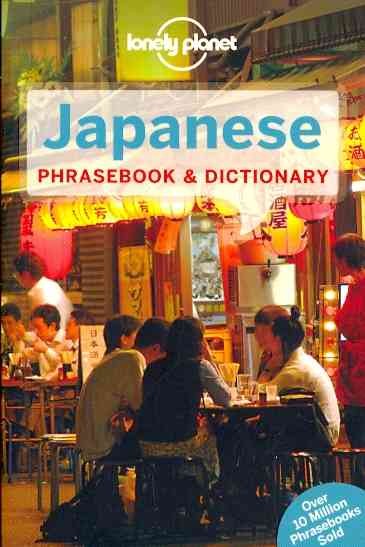Japanese Phrasebook - Lonely Planet

Lonely Planet Japanese PhrasebookTwo-way dictionary and Phrasebook |
 |
Lonely Planet Japanese Phrasebook - PaperbackPaperback - 271pp This phrasebook gets you on board the linguistic bullet train, stopping all stations to conversational perfection. If you want to know your shabu shabuya from your tonkatsuya, this guide is just the ticket.
About the Japanese LanguageJapanese is a language spoken by over 130 million people, in Japan and in Japanese emigrant communities around the world. It is an agglutinative language and is distinguished by a complex system of honorifics reflecting the hierarchical nature of Japanese society, with verb forms and particular vocabulary to indicate the relative status of speaker and listener. The sound inventory of Japanese is relatively small, and has a lexically distinct pitch-accent system. Japanese vocabulary has been heavily influenced by loans from other languages. A vast number of words were borrowed from Chinese, or created from Chinese models, over a period of at least 1,500 years. Since the late 19th century, Japanese has borrowed a considerable number of words from Indo-European languages, primarily English. Because of the special trade relationship between Japan and first Portugal in the 16th century, and then mainly Holland in the 17th century, Portuguese and Dutch have also been influential. German linguist, Johann Joseph Hoffmann noticed the systematic relationship between Japanese, Mongolian and Manchu language and wrote a book in the 19th century. The Japanese language is written with a combination of three different types of scripts: Chinese characters called kanji , and two syllabic scripts made up of modified Chinese characters, hiragana and katakana.. The Latin alphabet, rōmaji , is also often used in modern Japanese, especially for company names and logos, advertising, and when inputting Japanese into a computer. Western style Arabic numerals are generally used for numbers, but traditional Sino-Japanese numerals are also commonplace. The original language of Japan, or at least the original language of a certain population that was ancestral to a significant portion of the historical and present Japanese nation, was the so-called yamato kotoba , which in scholarly contexts is sometimes referred to as wa-go . In addition to words from this original language, present-day Japanese includes a great number of words that were either borrowed from Chinese or constructed from Chinese roots following Chinese patterns. These words, known as kango , entered the language from the fifth century onwards via contact with Chinese culture, both directly and through the Korean peninsula. According to some estimates, Chinese-based words may comprise as much as 60%–70% of the total dictionary vocabulary of the modern Japanese language and form as much as 18%–40% of words used in speech. Like Latin-derived words in English, kango words typically are perceived as somewhat formal or academic compared to equivalent Yamato words. Indeed, it is generally fair to say that an English word derived from Latin/French roots typically corresponds to a Sino-Japanese word in Japanese, whereas a simpler Anglo-Saxon word would best be translated by a Yamato equivalent. A much smaller number of words has been borrowed from Korean and Ainu. Japan has also borrowed a number of words from other languages, particularly ones of European extraction, which are called gairaigo. This began with borrowings from Portuguese in the 16th century, followed by borrowing from Dutch during Japan's long isolation of the Edo period. With the Meiji Restoration and the reopening of Japan in the 19th century, borrowing occurred from German, French and English. Currently, words of English origin are the most commonly borrowed. In the Meiji era, the Japanese also coined many neologisms using Chinese roots and morphology to translate Western concepts. The Chinese and Koreans imported many of these pseudo-Chinese words into Chinese, Korean, and Vietnamese via their kanji in the late 19th and early 20th centuries. For example, seiji ("politics"), and kagaku ("chemistry") are words derived from Chinese roots that were first created and used by the Japanese, and only later borrowed into Chinese and other East Asian languages. As a result, Japanese, Chinese, Korean, and Vietnamese share a large common corpus of vocabulary in the same way a large number of Greek- and Latin-derived words are shared among modern European languages, although many academic words formed from such roots were certainly coined by native speakers of other languages, such as English. |
Lonely Planet Japanese Phrasebook - Paperback |

 0 Items (Empty)
0 Items (Empty)